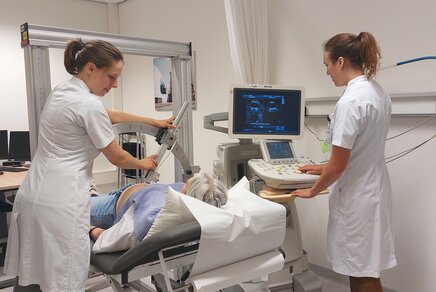Quality-of-Service-Adequate Wireless Receiver Design
Paul Detterer defended his PhD thesis at the department of Electrical Engineering on March 15th.
![[Translate to English:] [Translate to English:]](https://assets.w3.tue.nl/w/fileadmin/_processed_/a/8/csm_Detterer%20Banner%20image_d03e4ee17f.jpg)
In his PhD thesis, Paul Detterer extends the functionality of a wireless receiver for low-power Internet of Things applications. The receiver is equipped with an adjustable quality-of-service - energy trade-off knob, which allows a reduction of the receiving efforts in situations when the highest possible receiver performance is not required, and therefore helps to conserve energy. If the wireless channel is noisy or the incoming signal is weak, the modified receiver provides the highest possible quality-of-service to decode and correctly receive the signal. However, if the wireless channel is good or the incoming signal is strong, the receiver can be adjusted to receive the signal correctly with less effort and save energy.
Energy-efficient communication enables many new opportunities in Internet-of-Things (IoT) networks. Tiny flexible IoT nodes could operate for years on a single battery or forever using energy-scavenging techniques.
To be responsive during their run-time, IoT nodes are using their wireless radio extensively. Therefore, an energy-efficient radio is key to keeping the response latency low and maintain a long battery life. State-of-the-art commercial System-on-Chip solutions, such as TIs CC series or NXPs KW series, operate with constant power consumption above 10 mW, which is two orders of magnitude above the requirement or future small and flexible IoT devices.
To increase the energy efficiency of IoT radios, variability in channel conditions and application quality requirements can be leveraged. Instead of delivering constant quality-of-service required by an application for worst-case channel conditions, the IoT radio may adjust its performance and operate with lower power consumption with corresponding decreased quality-of-service while still meeting current application requirements under current channel conditions.
Circuit, communication, and network
The two primary operations of IoT radio are transmission and reception. In literature, the energy efficiency of those radio operations is addressed at the circuit level, the communication level, and the network level.
At the circuit level, energy efficiency is improved through the low-power circuit design of two parts of the radio, analog circuits in the Analog Front End (AFE) and digital circuits in the Digital BaseBand (DBB).
At the communication level, energy efficiency is addressed through modulation, channel and source coding, which enable the correction of errors induced by channel noise. Therefore, the signal can be transmitted with lower power.
At the network level, energy efficiency is addressed through smart transmission scheduling techniques that reduce duty cycling, and transmission and synchronization overhead. The most popular techniques are bundled in communication protocols for low-power networks such as IEEE 802.15.4. While the spent radio energy for transmission is dominant in common long-range networks such as mobile communication, the spent radio energy for reception becomes increasingly significant in emerging short-range communications, such as body-area and environmental-monitoring networks. Though some transmit-power adjustment techniques are also effective for short-range communications, energy-efficient adjustable reception is not yet fully explored.
Path to an adjustable receiver
With all of this mind, for his PhD research, Paul Detterer explored whether an adjustable receiver has the potential to improve the energy efficiency of an IoT device and what components such a receiver would need. The result of his research is a Quality-of-Service-Adequate Receiver (QoS-ARX) design. QoS-ARX design provides an adjustable receiver design that allows for the trade of signal quality and energy at multiple abstraction levels in a radio receiver.
First, Detterer identified the opportunities for an adjustable receiver in IoT networks to save energy. Those opportunities require a cross-level approach to identify an excessive signal quality at the network level and trade it for power at the circuit level. Examination of some general scenarios in wireless communication between IoT devices that use the IEEE 802.15.4 standard shows opportunities to save energy through an adjustable trade-off between Quality-of-Service (QoS) and power consumption of the IoT device during reception and Clear Channel Assessment (CCA). Detterer showed that receiver and CCA designs with adjustable performance can improve the total energy efficiency of an IoT device.
Second, to exploit QoS-ARX design over an entire IoT network, he proposed the use of Receiver-Sensitivity Control (RSC) techniques, which are complementary to the transmission-control techniques often used for network-level energy optimization. Detterer reported potential energy savings of up to 20% through RSC, compared to 7% savings through transmission-power control.
Third, to leverage these possibilities, Detterer proposed an adjustable-receiver design at the communication level with an accompanying receiver-sensitivity and energy-consumption model. The design combines several adjustable low-power components in an energy-efficient way. The combination of multiple elements with quality-power trade-off knobs enables trading power and quality across receiver components.
Finally, to improve the power efficiency of the radio’s digital components, he designed adjustable versions of two key components of the receiver, the CCA and the demodulator for reception.
Tools and insights
Together, the contributions presented in Detterer’s PhD thesis provide tools and insights for the design of a wireless receiver that improves energy efficiency beyond the state-of-art, through flexible quality-power trades across its components and across circuit, communication, and network abstraction levels.
The precise energy savings depend on the network configuration and channel conditions at hand. Such a receiver would be beneficial in receiver-dominated IoT applications like multi-hop environmental monitoring.
Title of PhD thesis: Quality-of-Service-Adequate Wireless Receiver Design. Supervisors: Twan Basten, Majid Nabi, and Hailong Jiao.
Media contact
Latest news


